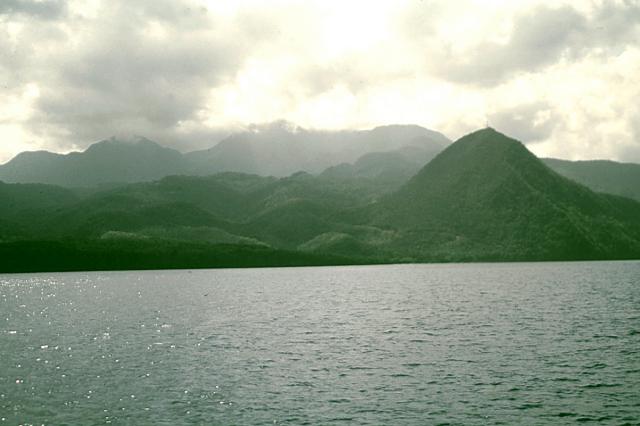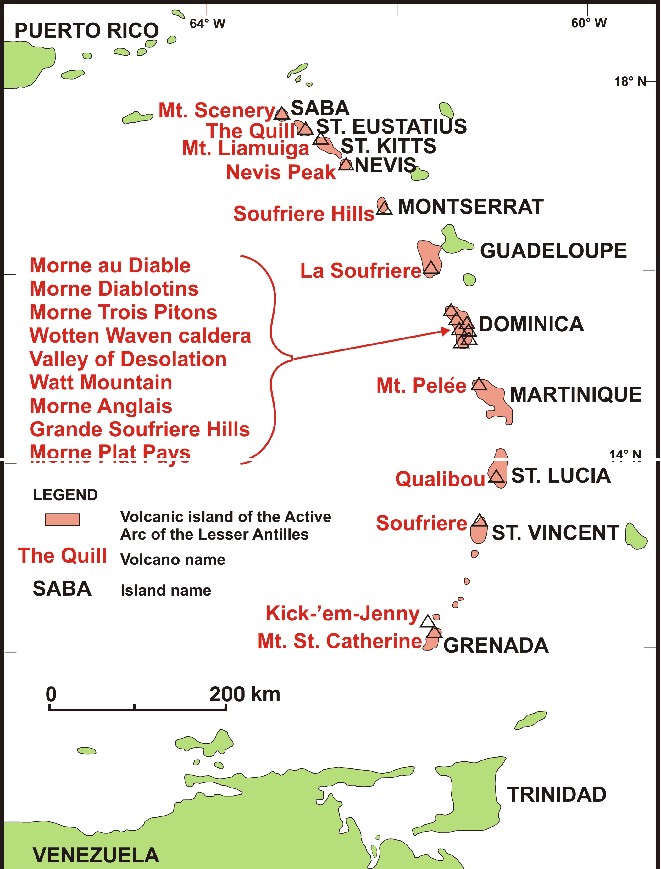Volume No. 2 Issue No. 2 - Friday May 25, 2007
The history and pictures of Dominica's volcanoes - Morne Diablotins
 By Thomson Fontaine By Thomson Fontaine

 Like most of the other volcanoes on Dominica, the largest and highest, Morne Diablotins has a french name. Translated, Morne Diablotins means small or little devils. It should not be confused with Morne aux Diables (Devil�s Peak), which is found a few miles away at the Northern tip of the island. Like most of the other volcanoes on Dominica, the largest and highest, Morne Diablotins has a french name. Translated, Morne Diablotins means small or little devils. It should not be confused with Morne aux Diables (Devil�s Peak), which is found a few miles away at the Northern tip of the island.
At 4, 747 feet (1430 meters), Morne Diablotins, is the second highest peak of the Lesser Antilles after Soufriere in Guadeloupe (1467 meters). Although there has been no eruptions on Morne Diablotins, the area was racked by severe earthquake swarms in 1841 and again in 1893. It was not however clear whether they originated from More aux Diables or Morne Diablotins.
A complex of at least five coalescing lava domes forms the summit of this imposing mountains with other domes found further to the south east. Pyroclastic-flow deposits from as early as 22,000-40,000 years ago extend outwards as far as the coast and is known as the Grand Savanne Ignimbrite. Block-and-ash flow aprons can be found on the north west side of the mountain.
Numerous hotsprings are found in close proximity to Morne Diablotins approaching the town of Portsmouth and below the waters of the Caribbean Sea.
 Nine of the Caribbean�s sixteen active volcanoes are located on the island of Dominica. By contrast there is one each on Guadeloupe, Martinique, St. Lucia, St. Vincent, Montserrat, Saba, St. Eustacius, St. Kitts, and Nevis. There are two in Grenada. Nine of the Caribbean�s sixteen active volcanoes are located on the island of Dominica. By contrast there is one each on Guadeloupe, Martinique, St. Lucia, St. Vincent, Montserrat, Saba, St. Eustacius, St. Kitts, and Nevis. There are two in Grenada.
Dominica�s nine active volcanoes are ; Morne au Diable, Morne Trois Pitons, Morne Diablotins, Morne Watts, Morne Anglais, Wotten Waven Caldera, Valley of Desolation, Grande Soufriere Hills and Morne Plat Pays.
The youngest dated volcanic deposits on the island are associated with the Morne Patates dome on the flanks of the large active Plat Pays Volcano that comprises the southwestern end of the island. This was a Pelean eruption (similar to the eruptions of Mt. Pelee on Martinique in 1902 and 1929) and radiocarbon ages from the block and ash deposits suggest it occurred about 500 year ago.
In addition there have been two steam explosions (phreatic activity) in the Valley of Desolation in 1880 and 1997. Frequent seismic swarms and vigorous and widespread geothermal activity today characterize the island. In fact it is the most worrying of all the Caribbean volcanic areas and there is a general feeling that it (like Montserrat pre-1995) is long overdue for an eruption. Scientists are predicting that there will be at least one major eruption within the next 100 years.
What is of particular concern is that the capital Roseau and most of the islands infrastructure lie on a pyroclastic flow fan derived from the Wotten Waven caldera situated on the eastern outskirts of the capital.
The pyroclastic deposits of the Roseau area abound with ignimbrites (pumiceous pyroclastic flows), surge and airfall deposits with radiocaron ages ranging from 38,000 to 1000 years B.P.
Volcanologist Haraldur Sigurdsson as long ago as 1972 described one of the units which he called the Roseau ash and together with other workers traced its submarine extension. As a result of this work they concluded that about 38,000 years ago the island erupted around 56 cubic kilometers of pumiceous materials in what was described as the largest eruption in past 200,000 years in the Caribbean.
Pyroclastic flows deposited about 30 cubic km on the Caribbean floor and the remainder was deposited on the Atlantic floor from AntiTrade Wind dispersal. More recent work suggests that there are several ignimbrite sheets separated by ancient soils and the deposits may have resulted from several eruptions. However all conclusions indicate that the capital Roseau is situated in one of the most hazardous areas of the island.
The Dominican.net will continue to bring you the history and photos of this aspect of our beautiful island over the next several issues.
Related Articles
The History of a Volcanic Island
The Morne Plat Pays (Flat Footed) Volcano
|
|





